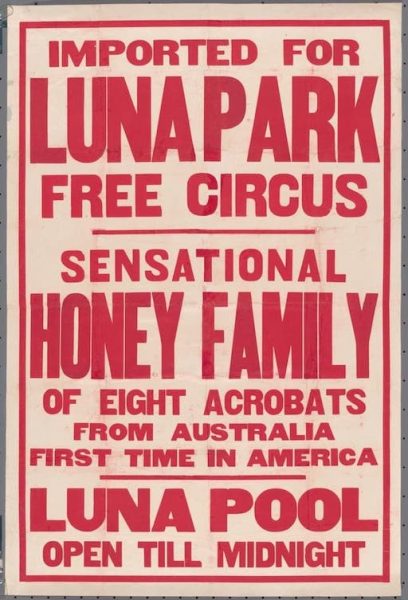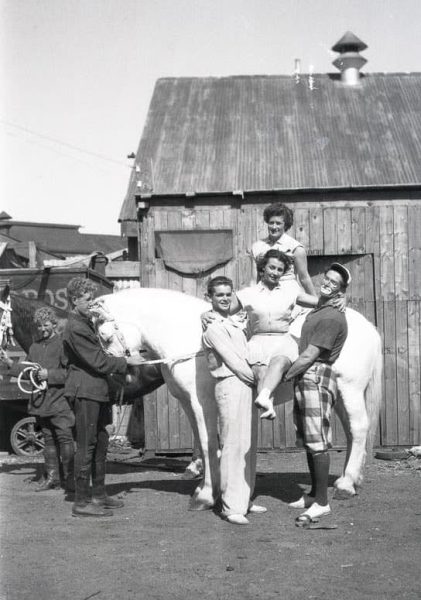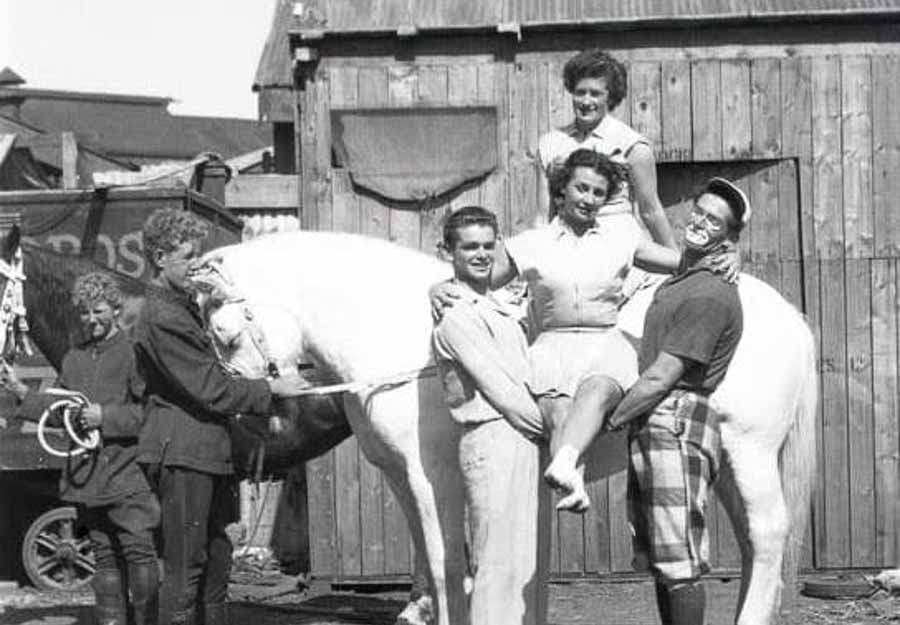The circus is a rich and vibrant part of Australian cultural history that continues to flourish in many different forms today. Some of the most famous international circus stars of the twentieth century were Australian; at the height of the industry, 17 large circuses were travelling the country at once.
Dive into the lives, travelling routes, performances and more of our country’s most celebrated circus troupes in Mark St Leon’s new website, ‘The Penny Gaff’, dedicated to the history of Australia’s circus and other travelling show people.
The Circus in Australia
From the early 1850s, travelling entertainers delivered to Australians an extraordinary diversity of culture … opera, minstrel, photographic, magic, bellringing, gospel singing, boxing, menagerie and carnival … However, the earliest demonstrable example of an Australian travelling show, and the most enduring, was the circus. – Mark St Leon, ‘The Penny Gaff’

THE HONEY FAMILY, A BRANCH OF THE ST LEONS, PERFORMING AT CONEY ISLAND’S LUNA PARK, 1926. [IMAGE COURTESY ‘THE PENNY GAFF’.]
The circus as we know it today emerged in mid-eighteenth century London, where displays of trick horsemanship—on open-air circular riding tracks each known as a ‘circus’, from where the modern circus got its name—were combined with clowns, rope-walkers, and gymnasts by former decorated cavalryman, Sergeant-Major Philip Astley.
Circus did not burst onto the Australian scene until almost a century later, when Robert Avis Radford—the ‘Tasmanian Astley’—pioneered the first successful colonial circus venture in Launceston in 1847-49. From there, the industry took flight. Henry Burton first took the circus on the road from Sydney in 1851; early travel routes carried performers between goldfields then, later, further afield. So popular was the itinerant tented circus that even bushrangers waved them through, rather than hold them up.
The twentieth century brought with it motorised transportation, alongside other challenges. The advent of cinema and later television; new municipal restrictions and unionised performers; and two World Wars in between changed the Australian circus forever. Many shut their doors, notably Wirth’s in 1963 after 80 years of domestic and international success. Performers such as the Indigenous tightrope walker Con Colleano—‘the Wizard of the Wire’—and the equestrienne May Wirth—‘the world’s greatest lady bareback rider’—found greater fame in America and Europe. By 1973, only four big circuses remained to tour Australia.
The circus has experienced a recent resurgence, adapting to the twenty-first century with such avant-garde troupes as Circus Oz, based in Melbourne, and the Flying Fruit Fly Circus, based in Wodonga. Contemporary or traditional, today’s circuses are descendants, no matter how far removed, of Astley’s great venture.
‘The Penny Gaff’

THE RIDING ST LEONS C. 1950: PEGGY ST LEON HELD BY BROTHERS LEO AND JOE, SISTER STELLA BEHIND. [IMAGE COURTESY RASHIDA JOSEPH, VIA ‘THE PENNY GAFF’.]
The ‘penny gaff’ was once London’s most popular form of entertainment. Cheap—the price of a penny—with the surprise or ‘gaff’ waiting behind canvas sidewalls, these outdoor equestrian shows birthed the modern circus as it is known today.
RAHS councillor and circus historian Mark St Leon has dedicated some 50 years to recovering the overlooked history of Australia’s circus and travelling show people, and is the author of Circus: The Australian Story (Melbourne Books, 2011). His new website, ‘The Penny Gaff’, contains a wealth of information and resources about Australian circus history. Explore a timeline and comprehensive travel route database; browse the archives of circus ephemera, portraits, film, and more; find out if your own ancestors were involved in show business.
‘The Penny Gaff’ also highlights the history of the St Leons: one of Australia’s original circus families.
Follow the long and winding road of Australian circus history here.
References:
‘Philip Astley’, Britannica, https://www.britannica.com/biography/Philip-Astley, accessed 4 March 2021.
Mark St Leon, The Penny Gaff, https://www.pennygaff.com.au/, accessed 4 March 2021.
Mark Valentine St Leon, ‘Colleano, Con (Cornelius) (1899-1973)’, Australian Dictionary of Biography, National Centre of Biography, Australian National University, https://adb.anu.edu.au/biography/colleano-con-cornelius-9789, accessed 4 March 2021.
Mark Valentine St Leon, ‘St Leon, Matthew (1826-1903)’, Australian Dictionary of Biography, National Centre of Biography, Australian National University, https://adb.anu.edu.au/biography/st-leon-matthew-13181, accessed 4 March 2021.
Mark Valentine St Leon, ‘Wirth, May Emmeline (1894-1978)’, Australian Dictionary of Biography, National Centre of Biography, Australian National University, https://adb.anu.edu.au/biography/wirth-may-emmeline-9158, accessed 4 March 2021.
Ruth Teale, ‘Burton, Henry (1823-1900)’, Australian Dictionary of Biography, National Centre of Biography, Australian National University, https://adb.anu.edu.au/biography/burton-henry-3123, accessed 4 March 2021.


0 Comments